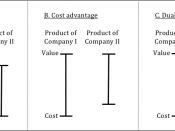In this paper we are going to look at the idea of Core Competences and explain what they are and how they affect an organisation. We will look to see whether these core competences are really the secret to success, whether this is the best strategy for an organisation. We will look at a few cases where organisations have employed the strategy of seeking out core competences and we shall look to see whether their strategy has been more successful than another organisation in their industry which did not focus on core competences.
The idea of competence in an organisation is not new, but core competence is relatively new as it points to it being the key to competitive advantage. We find that since management academics C.K. Prahalad and Gary Hamel introduced the concept in an article in the Harvard Business Review in 1990 managers now consider almost everything a potential competence.
But essentially what is a core competence?
Prahalad and Hamel describe it as a bundle of skills and technologies that enable a company to deliver fundamental benefit to customer. In the article by Prahalad and Hamel they cite numerous examples such as Canon who used their skills to integrate microelectronics, optics and precision mechanics to build superior cameras, fax machines, printers and copiers. Other examples included NEC, and 3M their article concerned mainly knowledge of technologies, however the concept of core competences has been extended to entail many types of skills and functions, including process engineering, production, new product idea generation and even corporate identity. As we said earlier managers are able to view everything as a potential competence.
Core competence is a future-orientated approach, which not only determines the current products and services, but more importantly future business opportunities. The notion of core competence also has a...



Core competencies.
Using one of the Strategic management tools to explain the importance of core competencies.
0 out of 0 people found this comment useful.